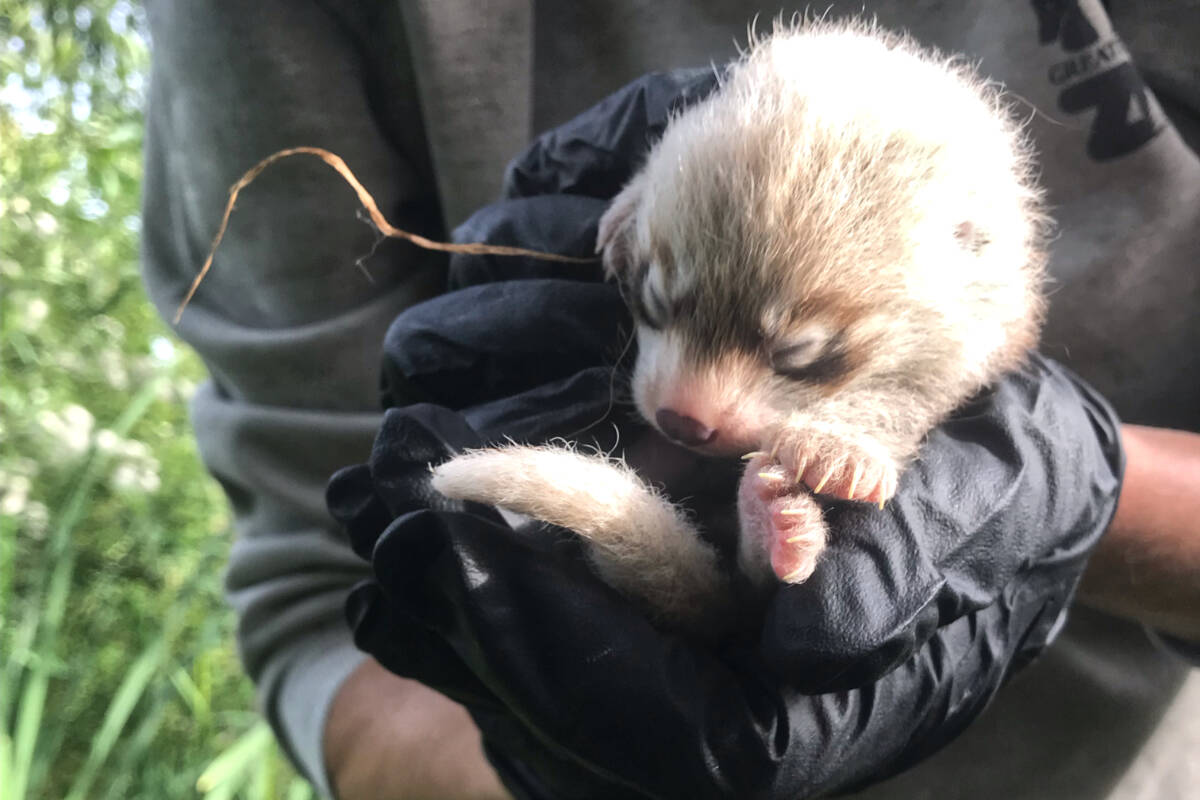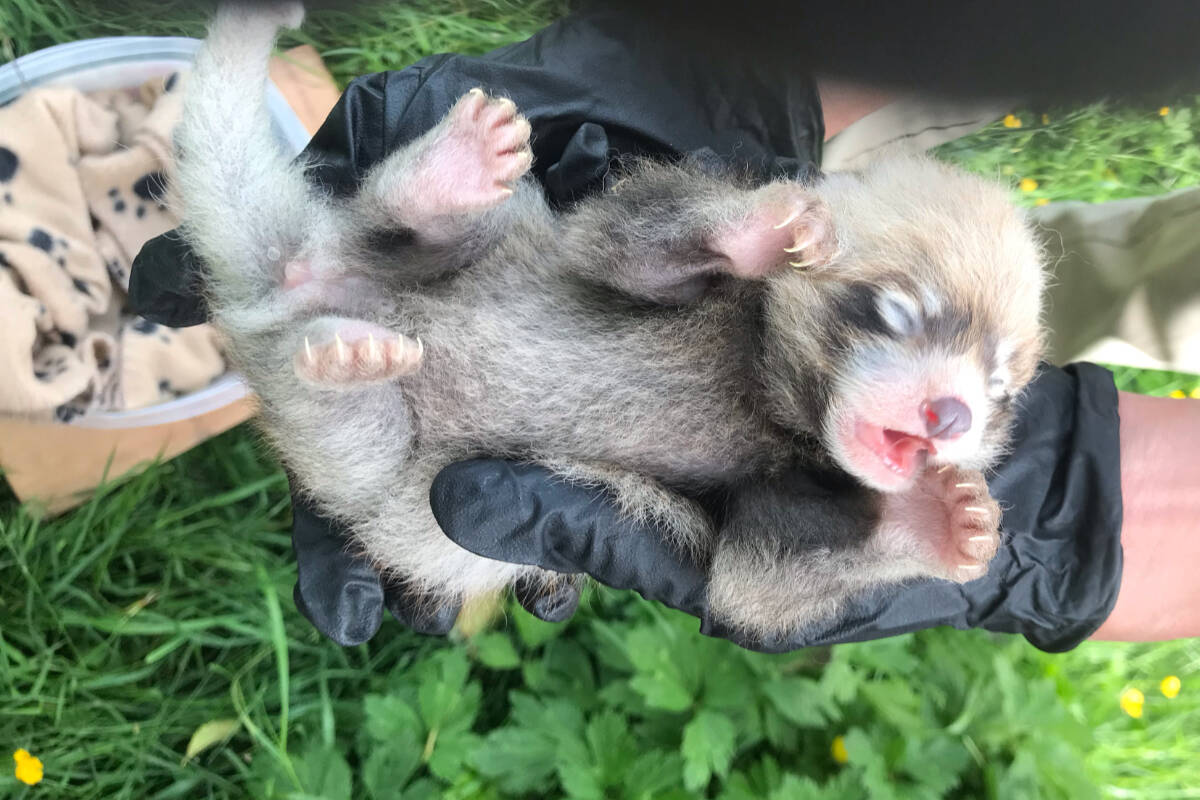By Frank Bucholtz/Special to Aldergrove Star
There are two new red pandas at the Greater Vancouver Zoo, and they are part of a much larger effort to help preserve and enhance this endangered species of mammal.
One is a male, the other a female.
Theirs are the first known births of red panda cubs in B.C., said Menita Prasad, deputy general manager and director of animal care at the zoo.
Red pandas are not panda bears. They are much smaller, and are also known as the lesser panda.
Head-to-body length ranges from 51 to 63.5 centimetres, (20.1 to 25 inches), with tails ranging from 28 to 48.5 cm (11 to 19.1 inches). They weigh between 3.2 and 15 kg (7.1 to 33.1 pounds).
Red pandas are an important species because they help keep balance in their ecosystem. Their native range is in Northern Myanmar, India, Nepal, Bhutan, and into the West Sichuan and Yunnan Provinces of China.
They are the last surviving species in their taxonomic family.
Their numbers in the wild are thought to be less than 2,500, and in many areas their habitat is fragmented due to human activity. As solitary animals, breeding is often challenging.
They have dense reddish-brown fur with a black belly and legs, white-lined ears, a mostly white muzzle, and a ringed tail.
They have curved, retractable claws and a thumb-like bone that helps them grip leaves, fruit, and narrow tree branches.
A red panda’s diet is 90 per cent bamboo. Their thick fur provides insulation from the cold.
Red pandas typically live solitary lives.
Zoo officials have observed that they are usually fairly quiet, but do make a lot of interesting sounds.
Most notable is something called a “huff-quack.” This sounds like a pig snort and a duck quack; they also make little squeals and twitters.
Red pandas are crepuscular, which means they are most active at dawn and dusk. On average, they spend about 45 per cent of the day awake.
The story behind the births at the zoo is an interesting one, Prasad explained.
At Assiniboine Park Zoo in Manitoba, a little red panda cub was born on June 28, 2014. He came to be known as Arun.
Once he was ready to leave his mom, he became part of the Species Survival Plan (SSP), which involves zoos and nature parks across the world.
Greater Vancouver Zoo in Aldergrove built a brand-new enclosure for his arrival.
He came to Aldergrove on May 28, 2015, and has been popular with zoo staff ever since.
He is very laid back and doesn’t get worked up about anything, though he is quite picky when it comes to food; he will only eat one specific brand of date. He is often motivated by bamboo, specifically bamboo shoots.
He’s also very energetic and has been seen bounding around the enclosure in playful ways.
His mate Sakura was also born in Canada, at the Granby Zoo in Quebec. Her birth date is July 1, 2013 (Canada Day) – so she is a true Canadian.
The SSP recommended her as a mate for Arun, and the two first met on March 4, of last year.
They get along very well, Prasad explained.
RELATED: Meet Sakura, Greater Vancouver Zoo’s newest red panda
Sakura is extremely motivated by food and loves sweet foods, most notably dates and pears. She often steals Arun’s sweet food because she just loves sweets so much. She is stockier than him, her face is bigger and rounder than his and also lighter in colour. She is the dominant one of the pair.
Red pandas usually breed from January through March, when the days start to get longer. Babies are born in the late spring.
During this time, bamboo shoots and leaves are the most tender and digestible and this helps the mother get adequate nutrition while raising her babies.
Females create nests in hollow trees, tree roots, and small enclaves, and pull leaves and other soft material into the nest.
Zoo staff pre-emptively built three nest boxes for Sakura and placed them in different areas of the enclosure. In January, she started pulling material into these boxes. This was followed by signs of obvious mating behaviours.
In April, she started to protect the nest boxes, and in mid-May she began to actively nest in one box in particular, Prasad recounted.
The zoo had planned to do an ultrasound, but that was scheduled for the day staff discovered the babies – June 14.
Keeper interaction is kept to a minimum to allow her to raise her cubs as naturally as possible, Prasad explained.
Sakura is described as an excellent mother, and very protective of her cubs.
A visual health check takes place daily, and there are regular weigh-ins. The cubs will soon be out and about in their enclosure, and will start getting really active when they start to eat solid food at three months old.
The cubs will be at the zoo for at least one year – the amount of time they stay with their mothers in the wild.
After a year has passed, SSP may pair them up with potential mates at other facilities.
This is a huge success for the SSP and major contribution to the ongoing conservation efforts of this endangered species.
“SSP programs are led by expert advisors who cooperatively work together to maximize genetic diversity, appropriately manage the demographic distribution and long-term sustainability of animal programs within the Association of Zoos and Aquariums (AZA). Breeding and transfer plans are developed with the goal being a healthy, genetically diverse, and demographically stable population for the long-term future,” according to a statement from AZA.
The birth of these red panda twins is part of the zoo’s commitment to conservation and education, Prasad said, noting zoo visitors may be able to see the cubs fairly soon, but are asked to be mindful and respectful when visiting.
RECENT: One wolf found dead, one missing after break in at zoo in Langley
.
Have a story tip? Email: roxanne.hooper@langleyadvancetimes.com
Like us on Facebook and follow us on Twitter.


